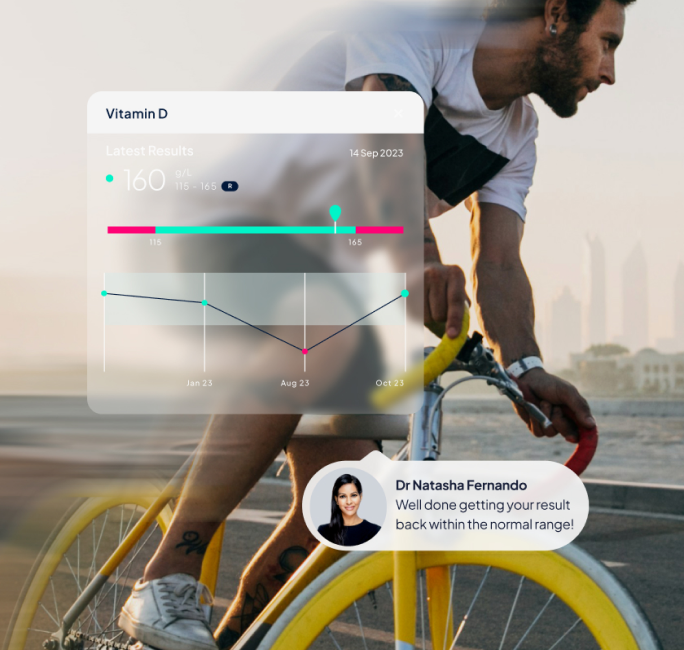Take your fitness to the next level with a detailed look at the biomarkers that can help you optimise your training and performance.

Go beyond the numbers
Get ready to elevate your health understanding with a personalised doctor's report. Go beyond results and tap into expert insights tailored just for you.
- Actionable advice
- Expert support
- Tailored recommendations

How it works
You have the flexibility to choose what works best for you. Enjoy the comfort of having a friendly nurse visit your home for a quick blood draw, opt for a convenient visit to one of our nationwide partner clinics, or self-arrange a draw at a location that suits you.
Take control of your health with Medichecks – order your blood test today!

Track, improve, and monitor your health over time.
MyMedichecks is your personal online dashboard where you can view your results, access clear and simple explanations about individual health markers, monitor changes in your health, and securely store information about your medical history, lifestyle and vital statistics.
What's in the test?
Adrenal hormones
DHEA sulphate
Learn more
Cortisol
Learn more
Cholesterol status
Total cholesterol
Learn more
LDL cholesterol
Learn more
Non-HDL cholesterol
Learn more
HDL cholesterol
Learn more
Total cholesterol : HDL
Learn more
Triglycerides
Learn more
Diabetes
HbA1c
Learn more
A raised HbA1c result points to diabetes or an increased risk of developing diabetes, which can have a significant impact on your lifespan and quality of life. Complications of uncontrolled diabetes include heart disease, kidney disease, eye problems, and vascular conditions. It can also contribute to mental health problems. And men with diabetes are three times more likely to have erectile dysfunction. Keeping your HbA1c within a normal range can help you reduce the risk of these conditions.
Hormones
Testosterone
Learn more
Testosterone : cortisol
Learn more
Inflammation
hs-CRP
Learn more
Iron status
Iron
Learn more
TIBC
Learn more
Transferrin saturation
Learn more
Ferritin
Learn more
Kidney health
Urea
Learn more
Creatinine
Learn more
eGFR
Learn more
Liver health
Bilirubin
Learn more
ALP
Learn more
ALT
Learn more
Gamma GT
Learn more
Proteins
Total protein
Learn more
Albumin
Learn more
Globulin
Learn more
Vitamins
Folate - serum
Learn more
Vitamin B12 - active
Learn more
Vitamin D
Learn more
Despite its name, vitamin D is actually a hormone that’s produced by your skin when it’s exposed to sunshine. Before your body can use vitamin D produced by sun exposure (known as vitamin D3), it must be converted into another form called 25 hydroxycholecalciferol (25 OH). Vitamin D (25 OH) is the major circulating form of vitamin D, and so your vitamin D (25 OH) level is considered the most accurate indicator of vitamin D supply to your body.
Vitamin D is essential for healthy bones and teeth, as it helps your body absorb calcium. It also plays a role in muscle health, immune function, and mental health.
Low vitamin D symptoms include muscle weakness, mood swings, and fatigue. Many people in the UK have low vitamin D levels, and people with dark skin and people who don’t spend much time outdoors are particularly at risk.
Small amounts of vitamin D can be obtained from food, especially oily fish, eggs, and vitamin-D fortified foods. But if you have a vitamin D deficiency, you’re unlikely to be able to improve your levels by food alone.
How to prepare for your test
Prepare for your Advanced Fitness Blood Test by following these instructions. Take your sample between 6am and 10am. If you have an unusual sleep pattern, your cortisol results may be unreliable. If you must test, do so within 2 hours of waking and inform us in the supporting information. Most evidence suggests that DHEAS is unaffected by the menstrual cycle, so taking the test at any point will give you a valid result. However, if you have regular periods and are tracking your results over time, we recommend taking the test between days two and five of your cycle for consistency. Take this test when any symptoms of short-term illness have settled. Avoid heavy exercise for 48 hours beforehand. Avoid fatty foods for eight hours before your test, you do not need to fast. Stay well hydrated before your test. Corticosteroid medication can affect this test, ask your doctor whether to stop before testing. Take your sample at least 24 hours after any vitamin or mineral supplements. Do not take biotin supplements for two days before this test, discuss this with your doctor if it is prescribed. Do not take vitamin B12 for two weeks prior to this test. If your B12 is prescribed ask your doctor whether to stop. Hormonal contraception can affect the results of this test. Taking a break from this and waiting for your periods to restart before your blood test will give more accurate results.
Test limitations
Reviews
FAQs
What can I learn from a fitness blood test?
With insights into muscle mass (testosterone), anaemia and low energy (iron status and vitamin B12), as well as stress and over-training (cortisol), you can also check nutritional markers which can affect your training progress. Our profile also includes tests for general health, such as liver and kidney function, cholesterol, and diabetes.
When should take this test?
You can take our test as a snap-shot at any time or take it over a period of time to track your results and help you understand what works for you.
What is a fitness blood test?
Our Advanced Fitness Blood Test is a venous test (which means your blood is taken from a vein in your arm) that offers an advanced understanding of biomarkers that can affect your fitness goals, whether in the gym or on the sports field.
Does this test measure high levels of testosterone?
Why have the male reference ranges for testosterone changed?
The reference range for testosterone has been adjusted to have a lower limit of 12 nmol/L to reflect guidance from the British Society for Sexual Medicine (BSSM) 2022.
Our medical advice regarding testosterone levels remains the same and we advise that if your total testosterone level is between the range of 8-12 nmol/L and you have symptoms of low testosterone you may be considered eligible for testosterone replacement therapy. If your testosterone level falls within this range but you have no symptoms this is considered satisfactory and no further action is required.




